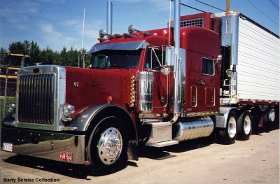Why You Should Learn To "float The Gears"
Topic 7740 | Page 3

Is there some advantage to double clutching?
No, there really isn't.
But once in a while you'll try floating gears and get stuck in gear for whatever reason. Like say for instance you're starting down a hill and you're loaded heavy. You're not paying attention cuz a pretty girl was walking down the sidewalk and you let your rpm's hit the governor before you tried shifting. Now you can't get it out of gear. You try "kicking" the throttle hoping when you let off quickly it pops out of gear but you're already at the governor so hitting the throttle does nothing. And you're being pushed downhill by the load you're carrying so it won't slow down quickly enough on its own to pop out of gear when you let off the throttle. You're stuck in gear. The only way to release the pressure off the gears so you can get it out of gear is to push in the clutch.
So knowing how to double clutch at least gives you that instinct to hit the clutch if its stuck in gear. But I mean, that's a stretch. That's not even double clutching but at least I get a point for thinking up a reason to use your clutch when shifting!
Other than the fact that the manufacturer of the transmission (Eaton-Fuller) prescribes it in order to prolong the life of the transmission, no, there is no advantage to "double clutching."
Floating Gears:
An expression used to describe someone who is shifting gears without using the clutch at all. Drivers are taught to "Double Clutch" or press and release the clutch twice for each gear shift. If you're floating gears it means you're simply shifting without using the clutch at all.
Double Clutch:
To engage and then disengage the clutch twice for every gear change.
When double clutching you will push in the clutch, take the gearshift out of gear, release the clutch, press the clutch in again, shift the gearshift into the next gear, then release the clutch.
This is done on standard transmissions which do not have synchronizers in them, like those found in almost all Class A trucks.
Double Clutching:
To engage and then disengage the clutch twice for every gear change.
When double clutching you will push in the clutch, take the gearshift out of gear, release the clutch, press the clutch in again, shift the gearshift into the next gear, then release the clutch.
This is done on standard transmissions which do not have synchronizers in them, like those found in almost all Class A trucks.
OWI:
Operating While Intoxicated
Other than the fact that the manufacturer of the transmission (Eaton-Fuller) prescribes it in order to prolong the life of the transmission, no, there is no advantage to "double clutching."
As long as we're dredging up an old post to comment on - it would do well to remind folks that DOUBLE-CLUTCHING IS A REQUIRED SKILL to pass a DMV road test. It's pretty easy to learn out to float - and a lot easier than grabbing the clutch twice for each shift.
SAVE THE FLOATING until after you pass the ROAD TEST.
I self-taught floating when I as in school - by the time I road tested, I had nearly forgotten how to DC, and failed my first road test on 23 missed shifts.
Once you have your CDL , doesn't really matter that much - UNTIL YOU DO - STICK WITH DOUBLE CLUTCHING.
Rick
CDL:
Commercial Driver's License (CDL)
A CDL is required to drive any of the following vehicles:
- Any combination of vehicles with a gross combined weight rating (GCWR) of 26,001 or more pounds, providing the gross vehicle weight rating (GVWR) of the vehicle being towed is in excess of 10,000 pounds.
- Any single vehicle with a GVWR of 26,001 or more pounds, or any such vehicle towing another not in excess of 10,000 pounds.
- Any vehicle, regardless of size, designed to transport 16 or more persons, including the driver.
- Any vehicle required by federal regulations to be placarded while transporting hazardous materials.
Double Clutch:
To engage and then disengage the clutch twice for every gear change.
When double clutching you will push in the clutch, take the gearshift out of gear, release the clutch, press the clutch in again, shift the gearshift into the next gear, then release the clutch.
This is done on standard transmissions which do not have synchronizers in them, like those found in almost all Class A trucks.
Double Clutching:
To engage and then disengage the clutch twice for every gear change.
When double clutching you will push in the clutch, take the gearshift out of gear, release the clutch, press the clutch in again, shift the gearshift into the next gear, then release the clutch.
This is done on standard transmissions which do not have synchronizers in them, like those found in almost all Class A trucks.
Dm:
Dispatcher, Fleet Manager, Driver Manager
The primary person a driver communicates with at his/her company. A dispatcher can play many roles, depending on the company's structure. Dispatchers may assign freight, file requests for home time, relay messages between the driver and management, inform customer service of any delays, change appointment times, and report information to the load planners.DMV:
Department of Motor Vehicles, Bureau of Motor Vehicles
The state agency that handles everything related to your driver's licences, including testing, issuance, transfers, and revocation.
TWIC:
Transportation Worker Identification Credential
Truck drivers who regularly pick up from or deliver to the shipping ports will often be required to carry a TWIC card.
Your TWIC is a tamper-resistant biometric card which acts as both your identification in secure areas, as well as an indicator of you having passed the necessary security clearance. TWIC cards are valid for five years. The issuance of TWIC cards is overseen by the Transportation Security Administration and the Department of Homeland Security.

Lol, I faked the double clutch on my test and floated the gears. The reason? I never learned how to double clutch. Floated from day one.
Double Clutch:
To engage and then disengage the clutch twice for every gear change.
When double clutching you will push in the clutch, take the gearshift out of gear, release the clutch, press the clutch in again, shift the gearshift into the next gear, then release the clutch.
This is done on standard transmissions which do not have synchronizers in them, like those found in almost all Class A trucks.
I still double clutch out of habit. Don't even realize I'm doing it. I can float but its not natural to me the way clutching is.
Double Clutch:
To engage and then disengage the clutch twice for every gear change.
When double clutching you will push in the clutch, take the gearshift out of gear, release the clutch, press the clutch in again, shift the gearshift into the next gear, then release the clutch.
This is done on standard transmissions which do not have synchronizers in them, like those found in almost all Class A trucks.
I started learning to float with my trainer and when I was assigned my first truck I floated all the time. His truck was a Prostar with a stiff clutch so know wonder I would want to float. My first truck was a Volvo with a rather light clutch but I really wanted to learn to float and continuedo to.
As someone put up earlier things you figure out while floating can be invaluable later and in the right circumstances.
Now sadly I'm in an automatic and it's kinda weird downshifting with the Jake.
New Reply:
New! Check out our help videos for a better understanding of our forum features

















Preview:
This topic has the following tags:
Tips For Shifting







 TT On Facebook
TT On Facebook
Thanks for the explanation Rick... that makes sense. Stop the rotation so you can get it in gear then start er up to get going.
OWI:
Operating While Intoxicated